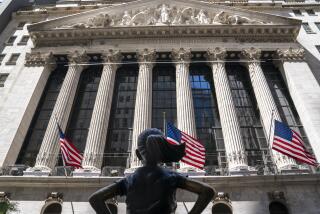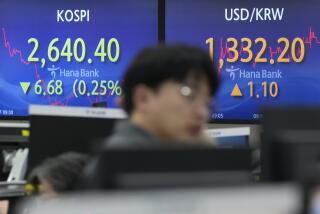Bullish? He’s Having a Bigger Red Cape Made
- Share via
Everybody’s a long-term stock bull these days, but Ralph Acampora was wildly bullish before wildly bullish was cool.
And the Prudential Securities analyst still is “out there,” as some of his peers might politely say: Acampora’s long-term target for the Dow Jones industrials is 18,500 by 2006, which works out to about a 10% compounded annual price gain between now and then--plenty of reason to stay in stocks, he figures.
The New York-based Acampora, a market “technician” by trade, has risen to fame in recent years largely as a result of a report he wrote in June 1995, titled “Dow 7,000.” In it, he laid out his case for the Dow index to climb to that level by 1998.
It was a bold call: The Dow was already at 4,500 in mid-1995, and a further 55% gain--even over 2 1/2 years--seemed outlandish to many on Wall Street.
But Acampora was right on. The Dow crossed 7,000 in February. Which, of course, necessitated that Acampora, who has been tracking the market’s technical trends (stocks’ momentum, trading volume, chart patterns, etc.) for 30 years, write another report.
Enter “Dow 10,000,” which Acampora penned in June. He now expects the Dow to reach that level by June 30, 1998. If he’s right again, the blue-chip index will gain another 26% over the next 10 months, measured from Tuesday’s close of 7,960.84.
In a bull market that has lacked many gutsy, high-visibility gurus, Acampora--a regular on TV’s “Wall Street Week With Louis Rukeyser”--obviously enjoys his star status. But reminded of other gurus who have rocketed to fame, only to eventually be humbled by the market (think Joe Granville, Robert Prechter, Elaine Garzarelli), Acampora admits to feeling “a little nervous” about his celebrity.
*
Even so, he thinks he’s in good company: Along with Goldman, Sachs & Co.’s low-key stock strategist, Abby Joseph Cohen, and Deutsche Morgan Grenfell Inc.’s oft-quoted economist, Edward Yardeni, Acampora is a torchbearer for the idea that the basic trends supporting stock prices are so strong that this bull market has a long way to run.
While in Los Angeles on Tuesday to meet with Prudential clients--about 1,500 were supposed to turn out for him at various locations--Acampora expounded on some of his key themes:
* Why this bull still has “legs”: He believes that 1994, when the broad market slumped as the Federal Reserve Board began to tighten credit, qualified as a bear market for most stocks. Therefore, Acampora counts the start of the current bull market as late 1994, not late 1990, which is most analysts’ starting point.
His argument being, this isn’t an “old” bull market. More important, he sees it as secular in nature, and powered in large part by aging baby boomers’ need to build up retirement nest eggs. “There hasn’t been a generation in the history of Wall Street so committed to buying stocks,” Acampora maintains.
Even so, he warns that temporary pullbacks, or corrections, are a “way of life” in a bull market, and will routinely shave 5% to 10% from the Dow--as occurred in the summer of 1996, again this spring, and perhaps in coming weeks.
But take a clue from the great, but volatile, 1962-66 bull market, Acampora says. He quotes Ken Ward, a respected technical analyst of that era, saying that “the biggest mistake we all made was that we sold the good-looking stocks too early.”
* What the next phase of this bull market will involve: Acampora sees investor demand for stocks broadening from the major blue-chip stocks to the “secondary” or smaller stocks.
Investor sentiment in a bull market inevitably progresses “from fear to greed,” Acampora says. In the early phase of a move, fear keeps many people in big-name stocks. As investors become more confident in their ability to make money in stocks, they naturally migrate into smaller, more speculative issues, he says.
Such a shift got underway in May 1996, he notes, but it ended quickly, as interest rate worries clipped stocks in June and July of that year. Investors poured back into blue chips last fall, as fear remained the dominant emotion.
*
In recent months, however, smaller stocks have begun to modestly outperform blue chips again. Acampora thinks that will continue. His conversations with dealers in smaller stocks suggest that the public’s appetite for those names has barely started to build, he says. As one small-stock trader told him, by way of race track analogy, “Don’t worry--they’re not at the $2 window yet.”
Acampora figures that “small and mid-cap names should support our secular bull for at least another six months.”
While many other market analysts believe that investor greed has already reached epic proportions, Acampora holds up a photocopy of a recent Fortune magazine cover, which suggested that investors might want to sell stocks now.
“You never have a bear market when you have this kind of stuff,” Acampora contends. “I think the pot is just starting to boil.”
* What will happen after Dow 10,000: Wall Street pros who have been waiting since 1990 for a genuine bear market--usually defined as a drop of 15% to 20% (at least) in indexes such as the Dow--will finally get their wish in 1998, Acampora predicts.
He expects that a decline of between 15% and 25% will follow the eventual surge in speculative buying that he foresees. But the bear market also will be over relatively quickly, Acampora says--within six months or so.
And after the 1998 bear market has run its course? “My theme will be to buy anything with a ticker symbol,” Acampora says. This is still a “once-in-a-lifetime market,” he says.
* What could go wrong with his forecast: He doesn’t expect long-term Treasury bond yields to rise much above 7.25% (the yield now: 6.67%). If he’s wrong about rates, “our story stops dead in its tracks,” Acampora says.
Also, if stocks in the near term run up much faster than he expects, he fears a much more brutal downside. “I want it to slow down here” for a while, he says.
* What accounts for his basic long-term optimism: “There’s a lot of ‘God bless America’ weaved into all this,” Acampora concedes. “It makes all the sense in the world that our stock market should go up, because we have more confidence in our way of life,” given the dramatic changes in the global economy since 1990--the fall of communism, the end of the Cold War, the resurgence of American industrial competitiveness, etc.
He doesn’t understand some social commentators’ worries about the prospects for so-called Generation X, the group that followed the baby boomers. “They have a cleaner, safer world than we had!” Acampora says.
More to Read
Inside the business of entertainment
The Wide Shot brings you news, analysis and insights on everything from streaming wars to production — and what it all means for the future.
You may occasionally receive promotional content from the Los Angeles Times.










